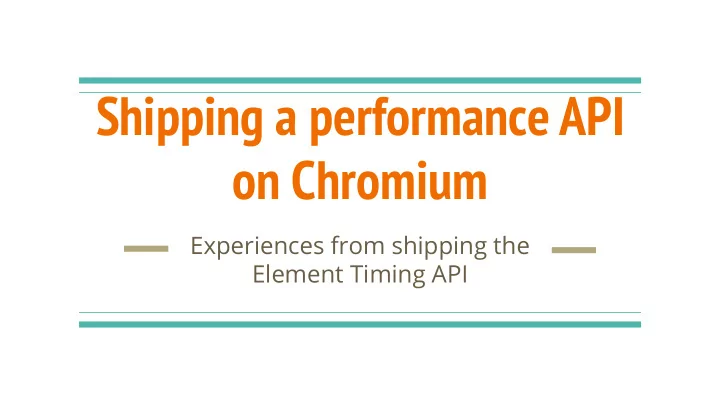

Shipping a performance API on Chromium Experiences from shipping the Element Timing API
Nicolás Peña Moreno Google Chrome Speed Metrics
Objectives of talk Explain the process involved in standardizing a web performance API and ● shipping it in Blink. I have a 42 step checklist :) ○ Encourage you to get involved! ●
Identify a problem For performance APIs: gap in measurement. ● Element Timing: measure image render time. ● From stevesouders.com blog: This is a hacky solution and does not necessarily provide an accurate timestamp.
Write an explainer: present problem Element Timing problem: Developers know which are the critical elements. ● Browser knows when content has been painted on the screen. ● Shubhie Panicker’s initial explainer:
Write an explainer: use cases What user needs can be satisfied? What are some examples of measurements that would be enabled by the new API?
Write an explainer: proposed solution? A proposed solution is NOT a requirement of an explainer! Not ideal to have a concrete solution. Element Timing proposal: Annotate hero elements ● Expose information via PerformanceObserver ●
Socialize explainer Present to W3C WebPerf and share explainer. ● https://lists.w3.org/Archives/Public/public-web-perf/ Publish on Web Platform Incubator Group (WICG) Discourse. ● https://discourse.wicg.io/
Develop concrete proposal (1) Move explainer to WICG on GitHub. ● https://github.com/WICG/element-timing Request design review from Technical Architecture Group (TAG). ●
Develop concrete proposal (2) Send Intent to Prototype ● (renamed from Implement).
Multiple Iterations
Implement the proposed API
Add web platform tests: harness Import the testharness to enable testing:
Add web platform tests: image Remove body margin and insert the hero image:
Add web platform tests: script
Draft spec Can reach out to experienced spec writer on IRC to get help through this process. Spec characteristics Prose and algorithms ● Written in ● Bikeshed/ReSpec Interactions with other ● specs (HTML, DOM) No Chrome-specific ● jargon (need to make sense for any implementer).
Internal launch review Performance APIs generally require internal privacy and security ● reviews. WebPerf WG or TAG may also surface privacy and security concerns, ● and these should be addressed before launching an API.
(Optional) Origin Trial https://github.com/GoogleChrome/OriginTrials/ Allows experimenting with a new (not yet shipped) web platform feature! ● Browser engineers love early feedback. ○ Changes to features after they have shipped can be hard. ○ Interested web developers sign up for tokens. ● Only a small portion of page loads can access origin trial. ● Prevents developers from depending on the experimental feature. ○
(Optional) Origin Trial: Intent to Experiment
(Optional) Origin Trial: feedback Peter Hedenskog (Wikimedia): We’d love to get more feedback from more developers, but we understand it’s a big time commitment to try out an API which may never ship.
Polish proposal Obtain signals from web ● developers and other browsers. WICG spec ● Chromium implementation ● Address feedback from TAG ● review.
Ship new API Send Intent to Ship and get approval from 3 Blink API owners. ● Ensure chromestatus.com has accurate information about the API. ● Flip implementation flag to ‘enable by default’. ●
Post-shipping work (1) Remove experimental flags. ● Continue conversations with WebPerf WG and eventually propose ● adopting the new API in the group. Address issues surfaced on GitHub repository. ●
Post-shipping work (2) Monitor usage and crashes ● We remove features that do ● not have multi-implementer support and have very little usage.
Summary:
Questions? npm@chromium.org Twitter: @NicPenaM GitHub: @npm1
Recommend
More recommend